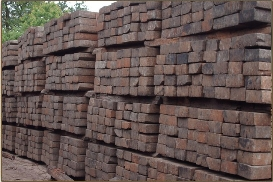Blog Archive
Fixing and using railway sleepers for your landscaping project
Fixing and using railway sleepers for your landscaping project
Posted Apr 6, 2011 by:

Using and Fixing Railway Sleepers
Many of our landscaping customers use new railway sleepers to create the look and feel that they require for their projects. Railway sleepers can be used all over the garden for raised borders/vegetable beds, driveway/path edgings and soil retention.
Retention
Generally the railway sleepers are laid lengthwise, whether on edge or flat will depend on the strength, preference and budget. To hold them in position for walls proposed to be 1M high or more then steel H section columns (known as UC or Universal Column) can be used. Lower heights can be accommodated more cheaply using part of a sleeper dug into the ground and erected in vertical fashion. The lowest heights of 150-400mm will require very little to secure the railway sleepers into position, depending on the length and shape (right angles tend to add strength).
We sell a range of railway sleepers that are suitable for all kinds of landscaping projects.
Raised Borders
It’s important to think about what’s most comfortable and practical for you when you are gardening. Also, consider where the bed will be positioned and whether you can stand or sit next to one side of the bed, or whether both sides are accessible.
Width
The width of a raised bed, which you can access from both sides, can be up to 1,000mm wide. At this width you should be able to reach all areas of the bed with ease. The length of the bed will then be determined by the space you have available and how big you want the bed to be. If you can only access the bed from one side, the maximum width is around 500mm.
Height
The height of a raised bed will be determined by what’s best for you. Think about whether you garden standing, sitting or kneeling, whether you’d like to sit on the edge of the bed and how it will look in your garden.
Railway sleepers
A bed made from railway sleepers will be extremely strong and long lasting, with an attractive natural look. Sleepers come in a standard size of 250mm × 200mm × 2,400mm.
You can use them horizontally, or cut them in length and lay them in the same way as timber posts.
Railway sleepers are wide, which means you have to reach further to get to the soil. To help minimise reaching across, you can lay them on their edge.
Building your raised boarders
Mark out your bed area then cut the sleepers to length and cut the ends to overlap at corners. Sink the bottom sleepers into the ground to half their depth, drill holes in the sleepers at 1m centres, 25mm wide by 75mm deep. Tap 150mm long dowels into the holes, fix the next layer of sleepers by locking dowels into matching holes. Drill and fix the next layer of railway sleepers. At corners and 1m intervals drive 1,000mm × 75mm × 75mm stakes into the ground inside your bed, burying half their length. Attach each sleeper to the support stakes using 200mm coach bolts. Line the bed walls with polythene to stop preservative leaching into the soil and then lay hardcore, permeable membrane and then the soil.
Weight:
The weight of railway sleepers varies depending on density, type, and age of the tree that hey came from. An example would be:
Pine 100-140 lbs
Oak 150-180 lbs
Beech & Jarra. 170-200 lbs
Azobe 200 - 240lbs
Size:
Most railway sleepers are approximately: (other sizes available on request)
8' 6" or 2.6 metres long
10" or 250mm wide
5" and 6" in depth
Cutting:
Cutting is best done with a chainsaw.
Move railway sleepers will require 2 people due to size and weight.
Recycled railway sleepers are different in appearance each side, so require rotating to get the right look.
Fixing
To fixing railway sleepers landscaping screws can be used which are strong steel screws available up to 250mm in length with a hexagonal head and fixed using a power drill. These will screw right through a sleeper and fix into the one below. They need an extremely high force before they pull out so they make a really strong joint.
An alternative method is TimberLok which has a clear 'anti-friction topcoat' allows it to penetrate the hardest wood more easily than other screws. They install faster than coach screws or bolts and do not requires drilling, with a countersunk finish.
These screws tighten up so powerfully, that they lock the railway sleepers together, this can make it harder to remove if required so you need make sure everything's correctly in position.
Treatment
The normal treatment for railway sleepers are either tar and creosote to lengthen the life of timber; ACQ / tannalised which is environmentally friendly; or simply untreated (if hardwood).
Railway Sleepers, available from our online shop.









